![[VIDEO] Ultrasound-Guided Injection for Trigger Finger](https://drjordijimenez.com/imagen/100/100/Imagenes/infiltracion-ecoguidada-dedo-resorte-drjordijimenez.jpg)
- Home /
- EXERCISES /
- SHOULDER EXERCISES /
- EXERCISES FOR SCAPULAR DYSKINESIS
EXERCISES FOR SCAPULAR DYSKINESIS
Scapular dyskinesis is an alteration in the movement or position of the shoulder blade. Although very common in athletes, it also affects the general population. This has been documented by studies showing a prevalence of between 6.7% and 66.7%. Although it is not considered a pathology in itself, its importance lies in its association with shoulder pathologies, and studies show that 43% of asymptomatic athletes with scapular dyskinesis will develop pain in the future.
Risk factors such as female sex, advanced age, obesity, and a sedentary lifestyle (for example, in office workers) also contribute to its development. Its cause can be proximal (muscle dysfunction, postural disorders, or nerve injuries) or distal, caused by conditions such as subacromial impingement, rotator cuff injuries, glenohumeral instabilities, SLAP injuries, swimmer's shoulder, or previous surgeries in the area.
An important causal factor is muscular imbalance, where an overactive upper trapezius can inhibit other muscles key to scapular stability. This imbalance creates a compensation pattern that contributes to dyskinesis. The importance of a low ratio between the upper trapezius and the middle trapezius, lower trapezius, and serratus anterior muscles is crucial: a low ratio indicates that the weaker muscles (middle and lower trapezius, and serratus anterior) are activated, with minimal activation of the upper trapezius, which is often overworked. This corrects compensations and restores the correct movement pattern.
Furthermore, deficits in flexibility of the pectotalis minor tendon, tightness of the upper trapezius, or the posterior capsule of the glenohumeral joint can cause scapular dyskinesis.
If you suffer from scapular dyskinesis, we recommend the following stretching exercises (to improve the flexibility of tendon and joint structures) and to strengthen the stabilizing muscles of the scapula.
Stretching and strengthening exercises for scapular dyskinesis
Pectoralis minor stretching exercise:
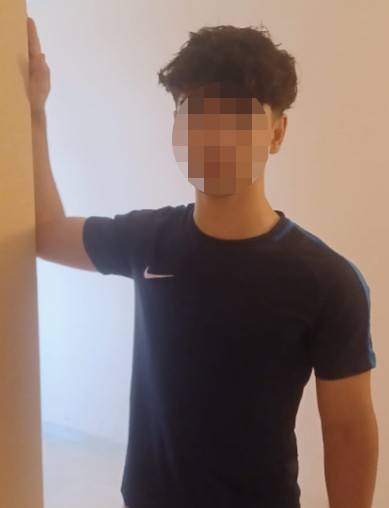
Figure 1: Unilateral Corner Stretch
Stand in front of an open door or corner. Place your elbow at 90° at shoulder height, with your forearm resting on the wall frame (Figure 1). Lean forward, stretching the pectoralis minor on that side. Notice the tightness.
When starting the stretch, it's crucial to avoid pain. You should stretch only until you feel tension in the muscle and tendons, and then hold that position for a while until the tension decreases. With practice, you can extend the length of your stretch, but you should never reach the point of pain.
Goals:
- Pectoralis minor muscle lengthening.
- Improves forward shoulder posture.
- Relieves shoulder pain.
- Improves shoulder joint balance.
- Prevents pectoralis minor syndrome.
- Prevents and treats scapular dyskinesis.
Passive stretching exercise for the Pectoralis minor and dorsal spine:
Passive pectoral stretch, lying supine (face up). Lie on your back with your feet flat on the floor and place a pool roller under your spine. Extend your arms outstretched, resting on the floor. Stay for a while (minimum 15 minutes). Breathe freely. You will gradually feel the stretch in your lats.
When you begin stretching, it is crucial to avoid pain. You should stretch only until you feel tension in the muscle and tendons, and then hold that position for a while until the tension decreases. With practice, you can extend the holding time, but you should never feel pain.
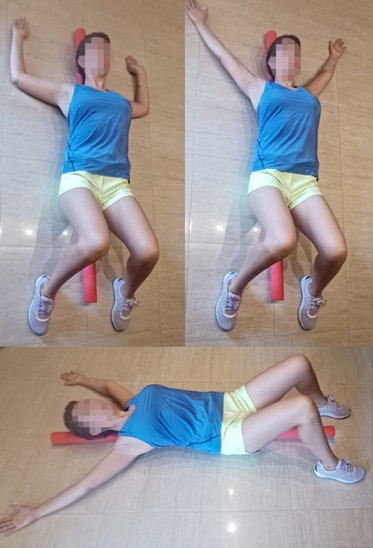
Goals:
- Pectoralis minor muscle lengthening.
- Improves forward shoulder posture.
- Relieves shoulder pain.
- Improves shoulder joint balance.
- Prevents pectoralis minor syndrome.
- Prevents and treats scapular dyskinesis.
Posterior Capsular Stretch of the Foot:
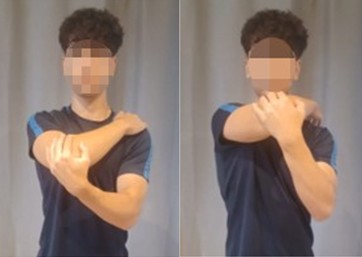
Standing. Place the assisting hand on the elbow. Bring the elbow toward the shoulder of the assisting arm until you feel a tightness.
When beginning stretches, it is crucial to avoid pain. You should stretch only until you feel tension in the muscle and tendons, and then hold that position for a while until the tension decreases. With practice, you can extend the holding time, but you should never feel pain.
Goals:
- Relieves tension in the posterior capsule and external rotators.
- Improves joint balance in internal rotation.
- Improves joint balance and shoulder stability.
Lying Posterior Capsule Stretch:
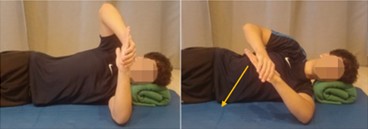
Lying on your side on the shoulder you are rehabilitating. Back straight. Scapula locked. With your elbow flexed at 90°, your assisting hand pushes your arm forward, trying to touch the table or floor. When starting the stretch, it's crucial to avoid pain. You should stretch only until you feel tension in the muscle and tendons, and then hold that position for a while until the tension decreases. With practice, you can extend the holding time, but you should never feel pain.
Goals:
- Relieves tension in the posterior capsule and external rotators.
- Improves joint balance during internal rotation.
- Improves joint balance and shoulder stability.
Cervical Lateral Flexion Stretch Exercise:
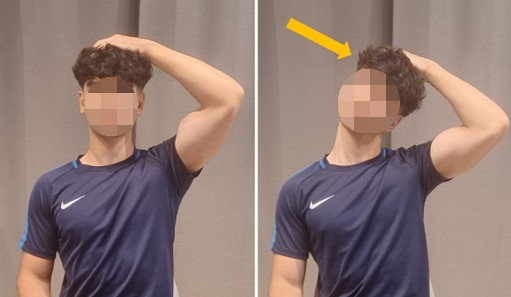
Standing or sitting in a chair. Back straight. Gaze forward. Place your hand on your head on the same side (this will assist you in the movement). Rotate your neck laterally to one side, as if trying to touch your ear to your shoulder on the same side.
When starting the stretch, it is crucial to avoid pain. You should stretch only until you feel tension in the muscle and tendons, and then hold that position for a while until the tension decreases. With practice, you can extend the holding time, but you should never feel pain. Do the same exercise on the opposite side.
Goals:
- Pain relief.
- Stretches and reduces muscle tension in the sternocleidomastoid, scalenes, upper trapezius, and levator scapulae.
- Maintains cervical joint balance.
Isometric low row exercise:
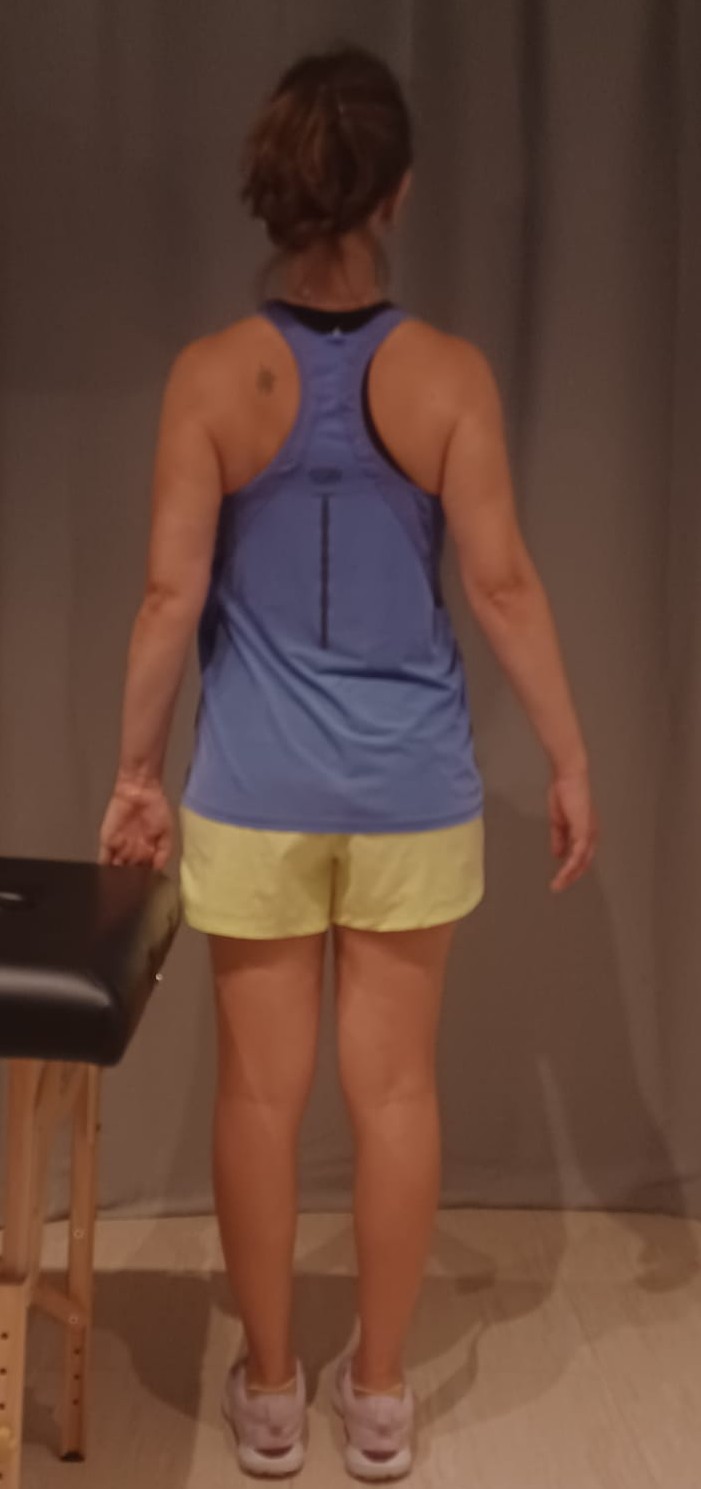
Stand with your back straight and the arm on the affected side extended alongside your body. The goal is to push with the palm of your hand against the edge of a table, exerting a backward force as if you were trying to row, but without moving your body or arm. Maintain constant force for 10 seconds. Do the same exercise on the other limb.
Perform:
- 3 sets on each limb.
Goals:
- Activation of the middle trapezius and rhomboids.
- Improvement of scapular retraction and stability.
Lawnmower Exercise:
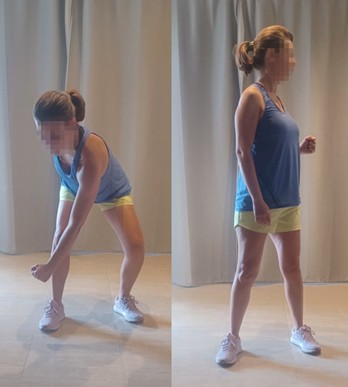
Stand with your feet shoulder-width apart. Step forward with the foot opposite your working arm. Slightly bend your knees and hips, keeping your back straight and your core engaged. The working arm should start crossed in front of your body, diagonally downward, with your hand near your opposite knee. Bring your arm back and up diagonally, as if you were starting a lawnmower. Bring your elbow back to your ribs, without raising your shoulder. Slightly rotate your torso while you retract and lower your scapula in a controlled manner. Return slowly to the starting position. Avoid sudden movements. Exhale as you pull the band and inhale as you return to the start.
Perform:
- 10 repetitions
- 3 sets
Goals:
- Activation and strengthening of the rhomboids, middle and lower trapezius.
- Coordinated activation of the core and dorsal muscles.
- Reactivation of the scapular muscles.
- Improved scapular control.
Stealing exercise/Face Pull with external rotation without elastic band:
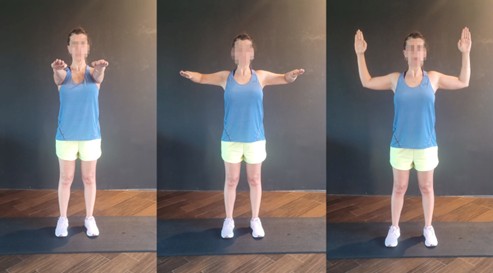
Stand with your back straight and your arms extended in front of you, at shoulder height with your palms facing down. Inhale and, with control, bring your elbows back until they are aligned with your shoulders. Bring your hands back until your palms face forward and your shoulders and elbows are at a 90-degree angle. The final position is hands up, like a steal. Hold for 5 seconds, feeling the muscle contraction between your shoulder blades. Return to the starting position, exhaling.
Perform:
- 10 repetitions
- 3 sets
Goals:
- Activation and strengthening of the rhomboids, middle and lower trapezius, and external rotators.
- Improved scapular control.
Wall push-up exercise:
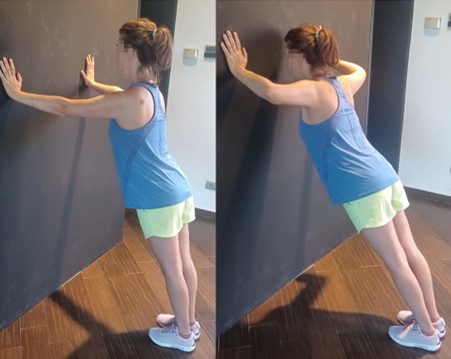
Stand facing a wall, about 50–60 cm away. Place your hands on the wall at chest height, shoulder-width apart. Fingers point upward. Elbows slightly bent. Trunk upright. Bend your arms at the elbows and bring your body closer to the wall. Return to the starting position, pushing off the wall as if you were trying to pull your shoulder blades back. Inhale as you approach the wall and exhale as you return.
Perform:
- 10 repetitions
- 3 sets
Goals:
- Improves scapular neuromuscular control.
- Activates the serratus anterior, middle, and lower trapezius muscles.
- Improves postural awareness.
- Progressive strengthening of the periscapular muscles.
External Rotation Exercise with Dumbbell:
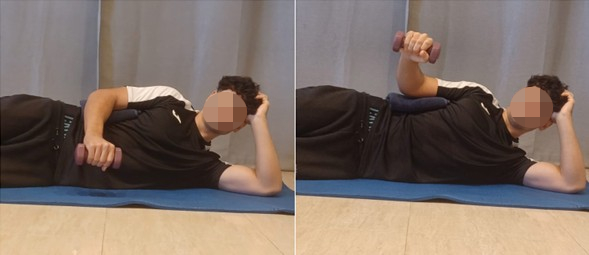
Lying on your side, place a towel between your arm and chest, elbow bent at 90°, and a dumbbell in your hand. Lift the dumbbell upward. Hold for 5 seconds.
Perform:
- 10 reps
- 3 sets
Goals:
- Strengthen external rotators.
- Relieve and prevent shoulder pain.
- Improve shoulder stability.
Towel wall slide exercise:
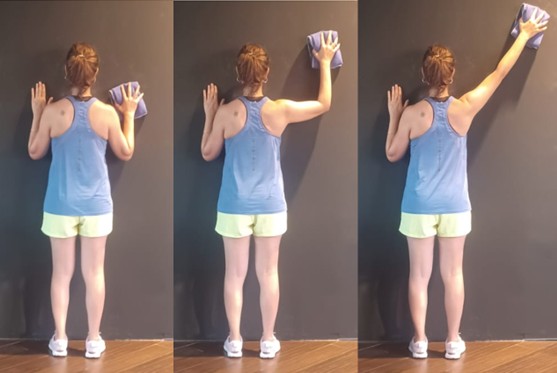
Stand facing a wall with a soft towel between your hands and the surface. Rest your forearms and hands on the wall, keeping your torso upright. From this position, slowly slide your hands diagonally up the wall, forming a "Y" shape if performed with both arms. Do not shrug your shoulders or arch your back. Return to the starting position, maintaining contact with the wall and scapular control at all times.
Perform:
- 10 repetitions
- 3 sets
Goals:
- Activation of the serratus anterior and lower trapezius muscles.
- Improves the movement pattern of the scapula.
Dumbbell Side-lying Forward Flexion Exercise:
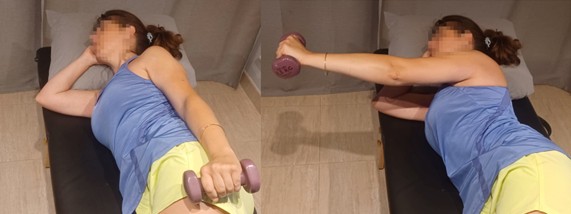
Lying on your side, with your head resting on a pillow or knee. Bend your lower arm (the one on your side resting on the floor) with your hand under your head. Rest your upper arm (the one you will be working on) alongside your body with a 2kg dumbbell in your hand. From this position, slowly raise your upper arm in front of your body in a shoulder flexion movement, until it reaches approximately head height. Return to the starting position.
Perform:
- 10 repetitions
- 3 sets
Goals:
- Activation of the serratus anterior and lower trapezius muscles.
- Improves the movement pattern of the scapula.
Prone extension exercise with dumbbell:

Lie face down on a table. Rest your forehead and your neck in a neutral position. Hold a 2 kg dumbbell in the hand of your working arm, which is relaxed and hanging from the table. Extend your arm back until it is parallel to your body. Avoid letting your shoulders rise toward your ears or causing any muscle tension in your neck. Once you reach the maximum extension, hold the position for 5 seconds and return to the starting position.
Perform:
- 10 repetitions
- 3 sets
Goals:
- Activation of the rhomboids, middle and lower trapezius muscles.
- Improves the movement pattern of the scapula.
- Improves the strength of the scapular stabilizers.
- Corrects altered patterns typical of scapular dyskinesis.
Prone horizontal abduction exercise in external rotation with dumbbell:
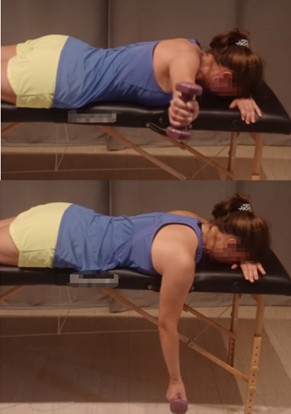
Face down on a table. Head and neck should be neutral. Grab a light dumbbell in one hand and let your arm hang toward the floor. The exercise consists of raising your arm in a controlled manner to the side, as if forming a "T" with your body. As you raise it, rotate the dumbbell so that your palm ends up facing forward with your thumb pointing toward the ceiling. Raise your arm until it is aligned with your shoulder without arching your back. Hold the position for 5 seconds. Return to the starting position slowly and in a controlled manner.
Perform:
- 10 repetitions
- 3 sets
Goals:
- Strengthening of the posterior deltoids, rhomboids, middle and lower trapezius muscles, and external rotators.
- Improved glenohumeral stability.
Prone extension exercise at 0º:
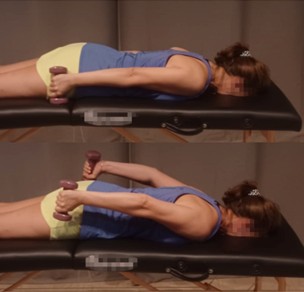
Face down on a mat or table. Head and neck in a neutral position. Arms extended alongside your body, palms facing up. Hold a 2 kg weight in each hand. The movement consists of raising both arms in a controlled manner toward the ceiling. Hold for 5 seconds. Return to the starting position slowly and in a controlled manner.
Perform:
- 10 repetitions
- 3 sets
Goals:
- Activation/strengthening of the rhomboids, middle and lower trapezius muscles.
- Improves scapular movement patterns.
- Re-education of scapular control.
- Improves the strength of the scapular stabilizers.
- Corrects altered patterns typical of scapular dyskinesis.
Push-up plus exercise:

High plank position, hands flat on the floor directly under your shoulders and arms extended. Lower your body by bending your elbows until your chest almost touches the floor. Push off the floor to extend your arms and return to the high plank position (Push-up). Once your arms are fully extended, push off the floor even harder. This will cause your scapulae to separate and move away from each other, slightly curving your upper back toward the ceiling (Plus Phase). Return to the starting plank position, allowing your shoulder blades to come together again, before beginning the next repetition.
Perform:
- 10 repetitions
- 3 sets
Goals:
- Activation/strengthening of the serratus anterior.
- Improves scapular movement patterns.
- Corrects altered patterns typical of scapular dyskinesis.
Wall Slide Exercise:

Stand with your back, head, and glutes against a wall. Place your feet shoulder-width apart and slightly forward. Bend your elbows to 90 degrees, keeping your upper arms and forearms flat against the wall, palms facing forward. Slowly slide your arms up the wall, as if forming a "Y" with your body, without letting your lower back move away from the wall. Keep your shoulders relaxed and prevent them from rising toward your ears. Continue sliding your arms through your full range of motion without losing contact with the wall. Then, return to the starting position in a controlled manner, slowly lowering your arms down the wall. Repeat the movement.
Perform:
- 10 reps
- 3 sets
Goals:
- Activation of the serratus anterior, middle trapezius, and lower trapezius muscles.
- Improve the movement pattern of the scapula.
- Increase shoulder range of motion.
- Posture correction, especially rounded shoulders and thoracic hyperkyphosis.
Protraction Exercise with Weights:
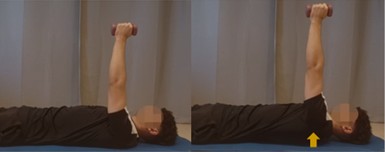
Lying on your back, hold your arm perpendicular to the floor with a 2kg weight in your hand. Lift your shoulder off the floor and raise your arm. Hold for 5 seconds.
Perform:
- 10 repetitions
- 3 sets
Goals:
- Strengthening of the serratus anterior muscle.
- Improved scapular stability.
- Improved postural control of the shoulder and scapula.
>> DOWNLOAD THESE EXERCISES FOR SCAPULAR DYSKINESIS HERE:  Exercises-for-scapular-dyskinesis-drjordijimenez.PDF <<
Exercises-for-scapular-dyskinesis-drjordijimenez.PDF <<
>> DOWNLOAD A SHOULDER EXERCISE COMPLIANCE CALENDAR HERE:  shoulder-compliance-calendar-drjordijimenez.PDF <<
shoulder-compliance-calendar-drjordijimenez.PDF <<
Make an appointment with Dr. Jordi Jiménez. He will see you in the center of Palma de Mallorca and help you regain your quality of life.

![[VIDEO] Ultrasound-guided infiltration of the lumbar facets](https://drjordijimenez.com/imagen/100/100/imagenes-pagina/sindrome-facetario-lumbar-drjordijimenez (1).jpg)
![[VIDEO] Ultrasound-guided infiltration of the hip joint](https://drjordijimenez.com/imagen/100/100/Imagenes/valgo-dinamico-rodilla-drjordijimenez.jpg)